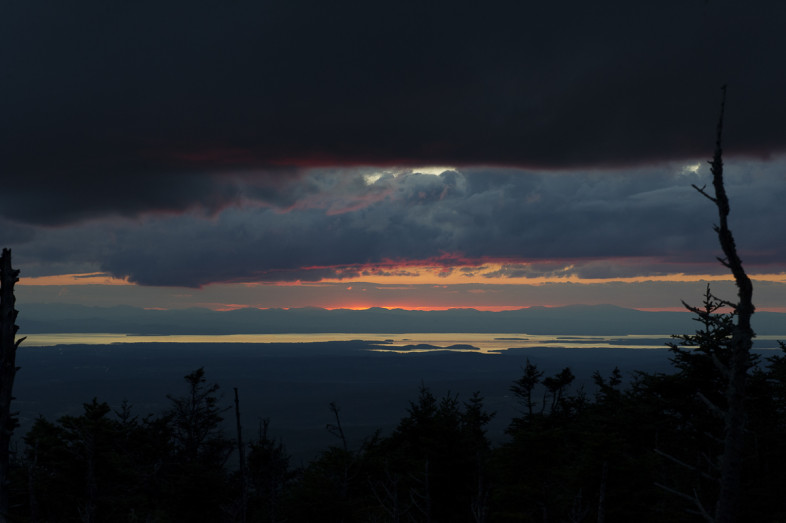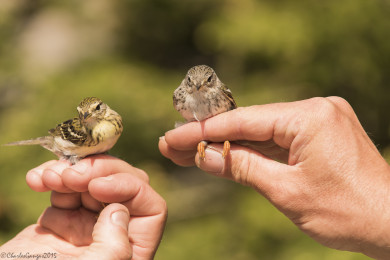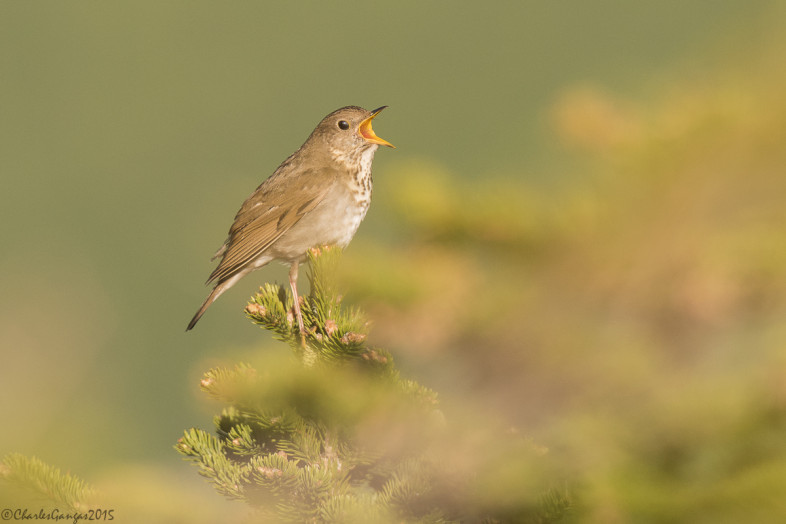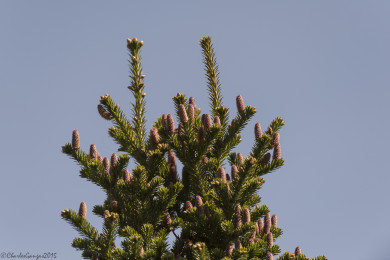
Sunset from Mt. Mansfield’s ridgeline, across Lake Champlain and the Adirondacks. Photo courtesy of Chuck Gangas.
Imagine being on Vermont’s tallest peak at 9:30 pm on a clear, cool evening without a whisper of wind. Sunset’s faint after-glow still peeks from the western horizon, while a moon just past full rises bright orange to the east, over the Worcester range. All is quiet and still, except that overhead a remarkable spectacle is underway. The dusk chorus of thrushes and White-throated Sparrows subsided 5-10 minutes ago, but the frenetic flight songs of several Bicknell’s Thrushes continue to burst from the dark sky above, as birds trace large circles 100 feet above, singing wildly. By 9:45, silence reigns.
Thus began VCE’s 2015 field season —our 24th— on Mt. Mansfield this past Wednesday night, June 3. After 2+ days of weather fit neither for bird or biologist, Noel Dodge and I arrived on the ridgeline at 5 pm to rare conditions — calm, clear and pleasantly cool. We set 16 mist nets and got to work. Our first capture: a female Blackpoll Warbler with an egg in her oviduct. Another unbanded Blackpoll, this one a male, and it was all thrushes until we closed our nets at dusk: 6 Bicknell’s and 3 Swainson’s. The dusk chorus was vibrant, as strong as it gets, with robins and white-throats complementing the Catharus thrushes, of which we counted 16 Bicknell’s and 6 Swainson’s singing. Flight songs provided the late show.
The evening’s final batch of mist-netted birds spent the night with us, each safely ensconced in a colorful cloth bag, in the ski patrol hut, where we bolted a quick dinner and recorded the 29.2-gram weight of our last banded Bicknell’s at 11:50 pm. The 4 am alarm had us up and out the door within 10 minutes, with all nets open for business shortly after 4:30. As usual, the dawn chorus was brief and less intense than the previous evening’s. Temperatures were in the low 40sF, the air was calm, and moonlight still bathed the ridgeline as dawn slowly lit the east. No question we were in for a good day.

Two female Blackpoll Warblers with distinctly different plumage, greenish on left, grayish on right. Photo courtesy of Chuck Gangas.
Netting over the next 7 hours kept us busy, never fast and furious, but steady, and we ended up with captures of 44 birds overall. These included 14 Bicknell’s Thrush (6 new and 8 returns from previous years, including 2 males from 2011), 8 Swainson’s Thrushes (6 new, 2 males from 2014), and 9 Blackpoll Warblers (4 males and 5 females, with a female from 2013 and a 2014 male). Rounding out our mist net totals were Yellow-belled Flycatcher (2), American Robin (1 male), Yellow-rumped Warbler (3), Dark-eyed Junco (1 male from 2014) and White-throated Sparrow (7). Birds encountered outside the nets included a family group of 4 Common Ravens cavorting around the Nose, 1 Red-breasted Nuthatch, 3 singing Winter Wrens (low numbers), 1 Nashville and 2 Magnolia warblers, a lustily singing Purple Finch, and 2 Pine Siskins calling overhead.
Not a single red squirrel was seen or heard, as expected following 2014’s low production of fir and spruce cones. However, a year from now will likely tell a different story, as Mansfield’s fir trees are laden with a bumper cone crop. In the absence of squirrels, which are major nest predators in summers following high cone production, Bicknell’s Thrushes and other montane forest birds should experience another strong breeding season. Time will tell, but VCE will be back on Mansfield weekly through late July to keep tabs on this vulnerable avian community.



Superb descriptive prose, thank you…any possibility you will ever record/post a little of the breathtaking BITH evening ‘concert’?